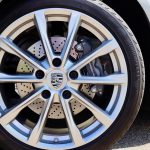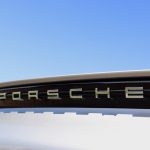HIGHLIGHTS
With two boots, effortless acceleration, unbeatable driving dynamics and classic Porsche quality, this is one of Stuttgart’s best new cars.
This is the 718 Boxster – one of Porsche’s most controversial models in the modern era, since the introduction of water-cooled engines in the 911 (thanks to the replacement of Porsche’s iconic flat six), with a newly developed turbo flat four.
With enthusiasts up in arms, I made it my mission to find out whether the 718 Boxster is still a real Porsche.
In short, yes! Of course it is, and here’s why.
Around the mid 1950’s, Porsche introduced a race car called the 718, which was powered by, you guessed it, a flat four engine.
Fast forward to the 21st century, and you see history repeating itself, however, with the addition of turbochargers to combat emissions and introduce more power. I mean, not all throw backs to early 20th century Germany have to be bad, right? The Boxster and Cayman were introduced at the turn of the century, offering customers a more cost effective alternative into Porsche’s sportscar range, and doubling up as much needed injection of funds to keep the Stuttgart brand alive.
These models featured a toned-down version of the very same iconic flat six engines that had been used throughout the 911 range, providing an iconic soundtrack and Porsche performance. However, as time moves on, the Boxster and Cayman began stepping on the heels of the 911, and thanks to new emission regulations, it was inevitable to see a new engine introduced to the sports car range.
Welcome the flat four engine, in which the same type of motor had been used more recently in Subaru’s. Sound was the biggest issue for Porsche enthusiasts, with a similar growl of the Japanese sedans, and raspy top end sound, this came as a shock to the usual customers as that swan song of a naturally aspirated flat six had suddenly changed.
At this point, we see the similarities between Subaru and Porsche stop. With a different way of being produced than the Subaru motor, and the use of even exhaust headers, Porsche have managed to produce their own unique sound. Add on the sports exhaust (which now comes as standard with the 718 range) and you get all the pops and bangs that are sure to excite.
This engine feels completely different from the flat six, as it feels more alive. Step on the accelerator and you get a surge of power from the 220kW turbocharged motor, which will keep rocketing to 100km/h in 5.1 seconds.
The iconic mid-engine layout of the 718 Boxster and Cayman allows for unmatched handling, so much so, that on a twisty track, with the same driver the 718 will be quicker thanks to the stability of having all that weight in the middle. The absence of motor from the front or rear of the car provides decent cargo space from two trunks on either end of the car, making it a great weekend getaway car, in comparison to its rivals.
The chiselled lines, larger side intakes, shark like front end and a pinched rear end all shake that bubbly Boxster shape – the end product, a ballistic missile that turns heads like nothing else.
As much as the introduction of a new engine has enthusiasts split, I can tell you now, that once you drive the 718, you’re misconceptions and opinions melt away. Especially when you drop the convertible top (which can be lowered and closed with the key) and listen to the gurgles, pops and bangs of the new motor.
Envision yourself in the present-day representation of those mid 50’s Porsche race cars, powered by the same style of engine.
As angry as you might be, or saddened by the absence of the flat six motor, remember, this is how Porsche should have built the Boxster from the beginning.
You can follow Cameron here at Hunter and Bligh or by subscribing to ‘Discovercars’ on YouTube and following him on Instagram and Facebook at @discovercars , for sneak peaks and other car content.







